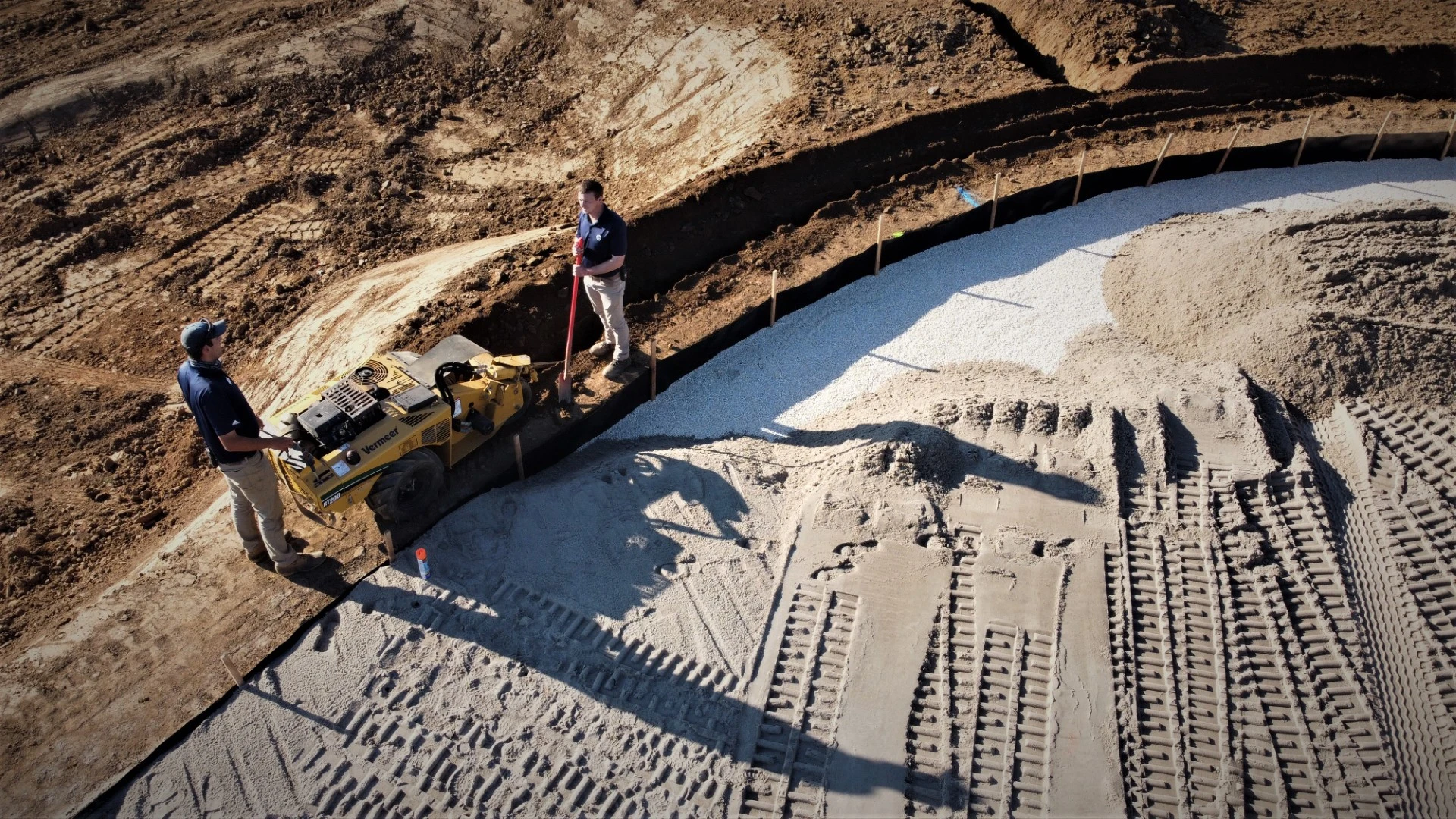
The fundamentals will always matter. The seeing, touching, feeling and smelling of pleasant outdoor surfaces attracted somebody like Curtis Tyrrell to the golf maintenance industry. They likely attracted many of you to the industry too.
Understanding, executing and mastering the fundamentals separate the solid from the spectacular, the shaky from the stable. Tyrrell oversees something spectacular: the turf conditions at Desert Highlands Golf Club, a revered Scottsdale, Arizona, club at the base of Pinnacle Peak.
Tyrrell’s role as director of agronomy involves leading a 38-worker team responsible for maintaining an 18-hole golf course, four grass tennis courts, four clay tennis courts, the grounds surrounding two clubhouses and common areas enjoyed by more than 550 members.
So much to do. So many decisions to make.
Fundamentals guide decisions. Supporting the hourly, daily, weekly, monthly, quarterly and annual agronomic decisions at Desert Highlands are increasingly more numbers on screens.
Data enters nearly every aspect of Tyrrell’s management programs. Soil temperatures. Soil moisture levels. Weather conditions within a two-square-mile radius. Equipment maintenance activity. Job assignments.
There’s a number for all of the above.

“It’s a totally different world from the old days,” says Tyrrell, who started his career in the early 1990s and has led turf teams in all four continguous U.S. time zones. “We have a lot more things at our fingertips. We’re pretty efficient, we do more with less people than we did in the past. The quality of the product is reaching new heights. We can get to our goals efficiently. I couldn’t imagine going backward and not having it.”
Golf course maintenance hasn’t fully embraced the Big Data era and Tyrrell concedes that Desert Highlands provides his team with significant resources. But with superintendents and their teams bracing for another year of frantic on-course activity — too many golfers, too few employees, not enough time — 2024 seems ripe for a numerical nudge.
Let the data conversation intensify!
What is data?
Unknowingly, many golf maintenance pros are already using data to support decisions.
“What we have to realize is what data is: It’s written-down observations,” says Dr. Bill Kreuser, the president and co-founder of GreenKeeper, a service offering science-based information, products and recommendations to turfgrass managers. “Superintendents are some of the most observant people and they keep track of what they are seeing. Turning it into data is the next step of writing it down or logging it somewhere so that you don’t live in the moment, and you can look for long-term trends.”
Bodo Sieber, the CEO of Tagmarshal, a system designed to help golf facilities navigate on-course traffic, compares a golf course to the human body. Data ensures operations are conducted at peak efficiency.
“If you go for a health check and you know what your critical body KPIs are, you can make better decisions, and adjust your lifestyle,” Sieber says. “If you’re trying to run a marathon, trying to get fit, and if you don’t engage the science behind what your body needs, then you’re going to try, but you’re going to fail. It’s the same with a golf operation.”
Sieber adds that data comes in two forms: what’s happening in real-time and what has happened over time. Soil and air temperatures, golf cart and maintenance vehicle movement, and soil moisture levels are examples of real-time data being accumulated on golf courses. Clipping yields, Growing Degree Days, and spray and fertility records are examples of historic data.
How intimidating is it?
Tyrrell understands why some superintendents from his generation might be reluctant to try or adopt new technology. An emerging platform, after all, is one extra thing to incorporate into packed days. But Tyrrell’s experiences indicate effectively using data improves his work — and personal — life.
“It’s not that hard to use,” he says. “I would say give it a try. It’s helpful. It adds time back to my work-life balance. I would take that any day of the week.”
Kreuser recommends starting simple. This can involve writing green speed on a calendar or measuring clipping yield and inputting the volume into a software program. Transferring visual observations into writing represents an easy foray into data, according to Kreuser.
Not a numbers person? Numerous emerging platforms are automating data and presenting course information via charts and graphics. “Data needs to be presented well,” Sieber says, “and data is not just numbers.”
Still uneasy?
More formal education about collecting and interpreting data will be appearing at upcoming industry events, according to Steve Dorer, the head of digital platforms for Syngenta’s Professional Solutions Business. Industry companies also offer training programs and demonstrations.
“We’re trying to put ourselves in a position to help superintendents overcome that fear or really come to grips with an understanding of what this digital age means,” says Dorer, a former golf course superintendent. “We’re more than happy to help. It takes a step, but most superintendents would be surprised that they are already taking steps in that direction.”
How can data help?
In addition to conducting research and working with turf managers, Kreuser assists in the maintenance and management of Jim Ager Memorial Golf Course, a 9-hole, par-3 layout and learning center in Lincoln, Nebraska. Measuring clippings and tracking growth rates supports fertility decisions on Ager’s greens, while data provided via a sensor resulted in a steep fertility reduction on fairways, according to Kreuser.
“Having that consistent product is important and we have overall doubled the amount of rounds at the par-3 at Lincoln Ager, because people know when they go there they can expect consistent, firm, fast putting greens and they can work on their short game,” Kreuser says. “Having consistency in the end product is important for the course.”
Using data collected via a traffic management platform can lead to a direct ROI. Studying historic and live traffic patterns can help operators adjust tee time and better position maintenance employees around play. Data on how long it takes golfers to play holes can be incorporated into course setup decisions to boost pace of play.
“Even if we can shave two minutes off these two holes, three minutes off that hole, one minute on this hole and two minutes at the halfway house, we have shaved off 10 minutes,” Sieber says. “That means one additional tee time that we never had. One more tee time means four times $80 the club never had.”
Sieber’s company recently worked with a course in Colorado to determine why one hole took nearly five minutes longer to complete than its projected time. The data they collected determined a medium-sized bush impeded play. The bush was removed. “It was a very low-cost exercise, and they never would have known that, because there are a lot of those bushes on the course,” Sieber says. “None were an issue besides this one.”
Sieber adds that effective data integration using automated programs will clear time for the most important and often most enjoyable part of a golf job: cultivating relationships.
“Very often at a golf facility the staff needs to make things work while their hair is on fire, because they are short-staffed and there’s always more to do,” Sieber says. “The less time I have to run around and try to make things work at my golf course, collect data points and use reams of paper to write down things so that I can stay ahead of things, the more time I have to build relationships and add to the experiences of the players I’m serving.”

What’s usable? What’s useless?
Superintendents and their teams prioritize tasks every day. The same mindset must be demonstrated when incorporating data into decision making.
“With any data you are collecting, make sure there’s an actual actionable reason to do it,” Kreuser says. “Don’t collect data to collect data. That’s not helpful. You want to have a clear idea … I’m doing this for this reason and I’m going to adjust my management as a result … and then you want to make sure the data you are collecting is actually related to what you think it is. Correlation isn’t causation all the time.”
Tyrrell has learned to find practical balances at Desert Highlands.
“There’s a threshold and point of diminishing return for everything,” he says. “On an 18-hole course, do I need 30 or 40 soil sensors when I’m out there with two or three assistants with whatever I’m doing every single day? Heck no. I’m walking, feeling and touching the course myself. I don’t need 30 of those data points, but a dozen is good. I can get the hot spots, the areas that I know I would like to have that information.”
Will data take my job?
Golf and golf course maintenance is big business. Any savvy business owner understands highly trained people capable of interpreting data must be employed to protect significant investments in equipment and infrastructure.
“I think the superintendent will become even more valuable,” Dorer says. “The skills they might need will change a little, but I think their value will only increase, because who else is going to manage all this automation designed for turf maintenance or golf course maintenance? It has to be a superintendent who understands how to use it.”

What’s next?
Sieber admits that golf lags behind many other industries in collecting data besides basic financial information. He sees positives in the slow start.
“The good news is that it’s obviously easier to jump onto something that another industry has pioneered,” Sieber says. “They have done the hard part. If it took another industry 10 or 15 years to get to a certain point, you can hopefully get there in eight years or shorter.”
Dozens of effective apps and platforms have entered the golf maintenance market over the past decade. And dozens more are coming.
“The adoption curve will accelerate over the next three years and technology will continue to get better and improve,” Dorer says. “There was a day when the handheld soil monitoring devices weren’t on a golf course. Now pretty much everybody has one.
“What’s the next step? What do you do with that data? Right now, it’s helping maybe in daily operations, but I think where it’s going to help is in more planning and providing higher levels of predictability.”
Predicting exactly where, when and how superintendents will incorporate and utilize data might be as tricky as winning a March Madness office pool. Superintendents are a fundamentally imaginative group.
“The creativity and inventiveness in how to apply some of these tools by superintendents is really amazing and we’re actually counting on that,” Dorer says. “We know that we can’t think of all the different ways they can use data.”

Explore the January 2024 Issue
Check out more from this issue and find your next story to read.
Latest from Golf Course Industry
- Standard Golf announces new product lineup for 2025
- The Salt Pond taps Troon for management
- KemperSports selected to manage Swansea Country Club
- From the publisher’s pen: Grab that guide
- Introducing our April 2025 issue
- South Carolina leaders honor golf course superintendent
- One and only
- Wild can be good






